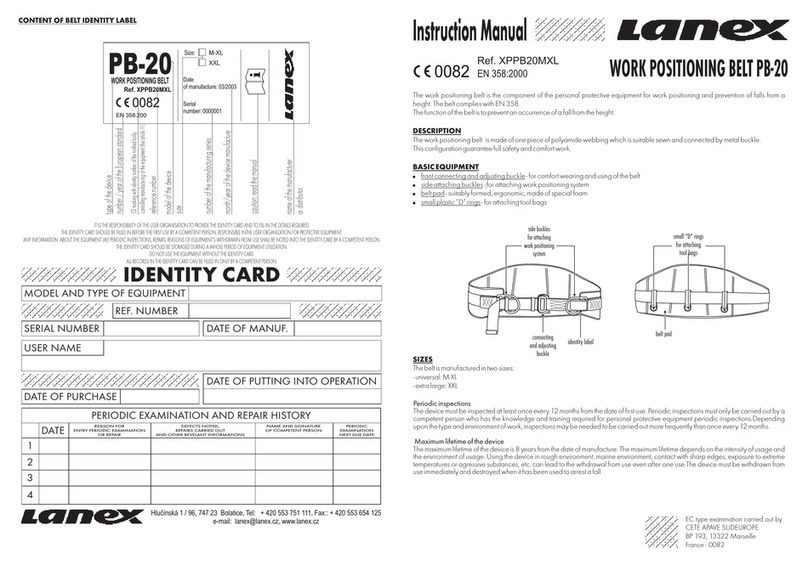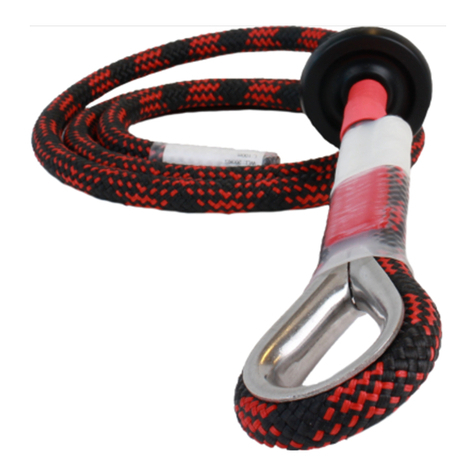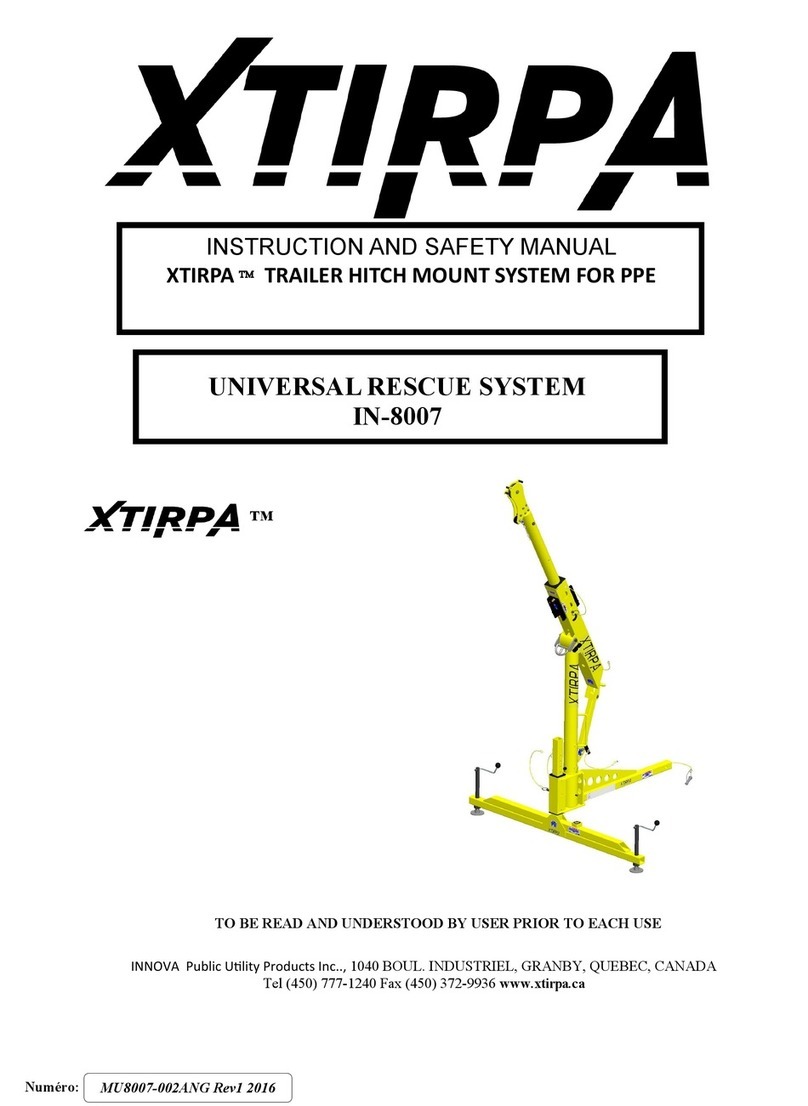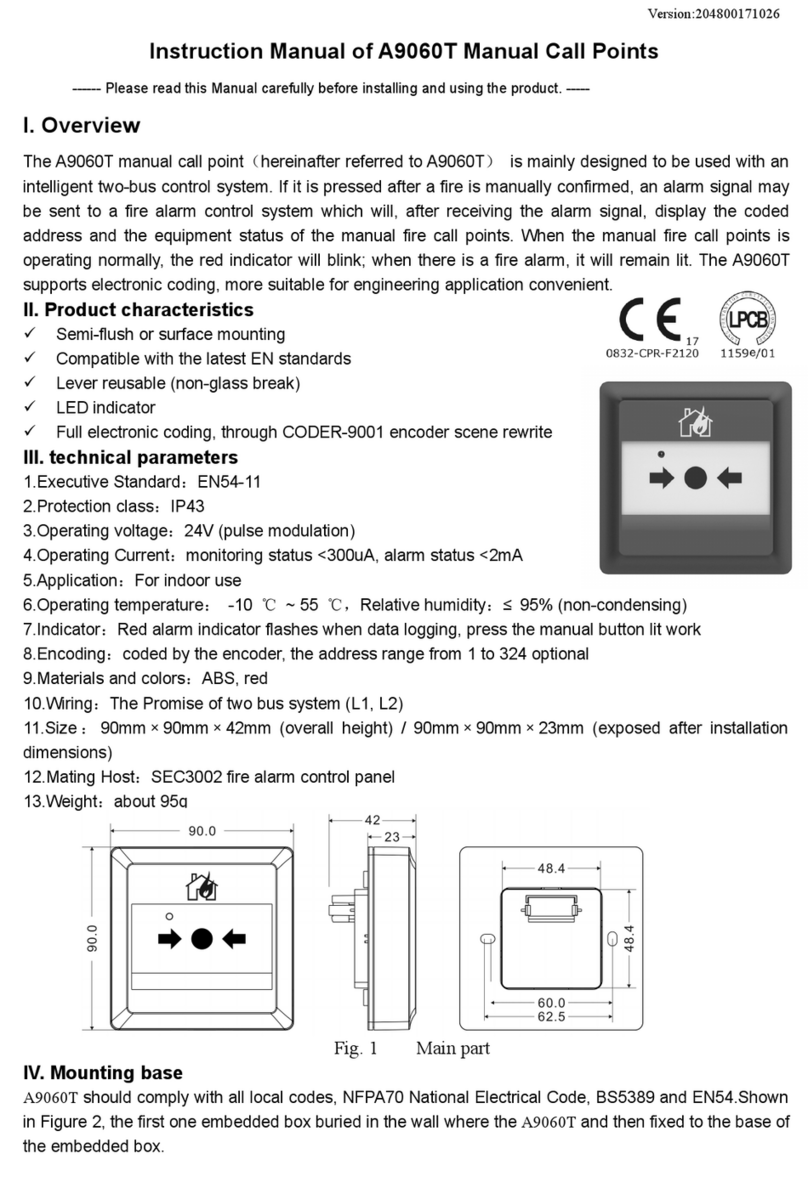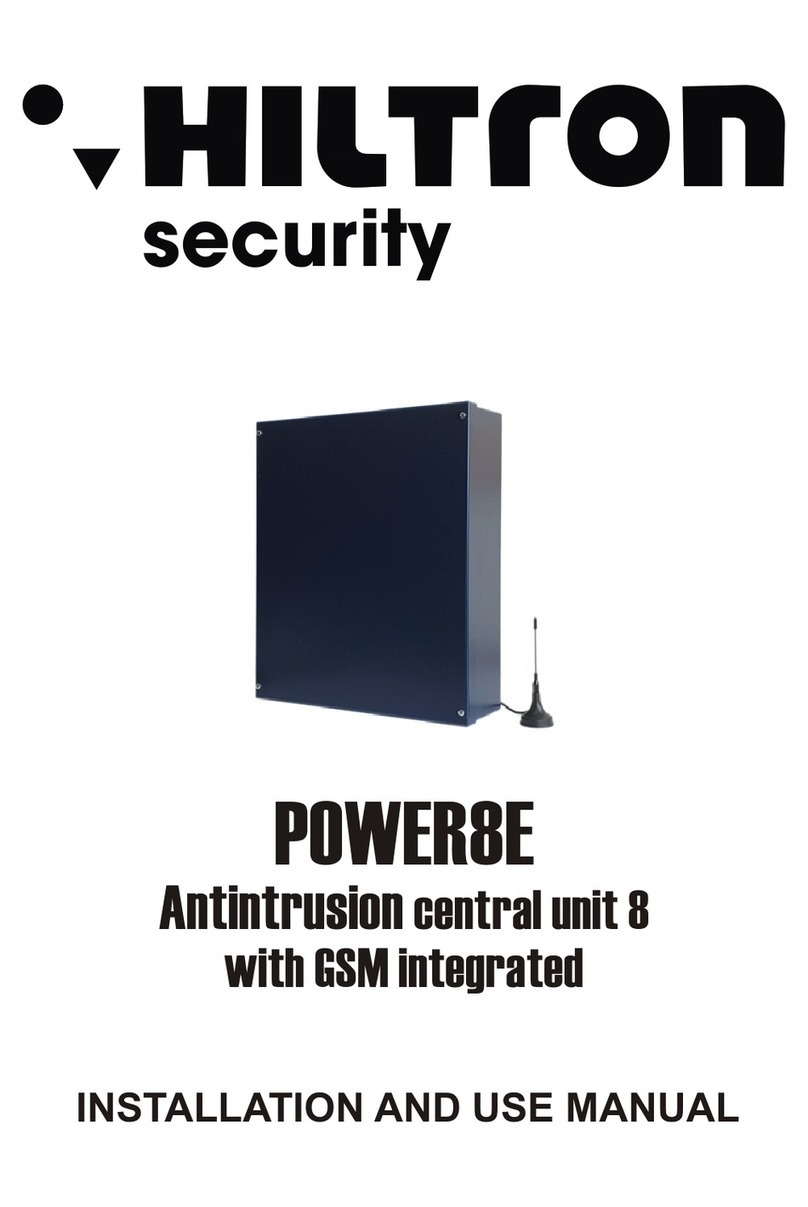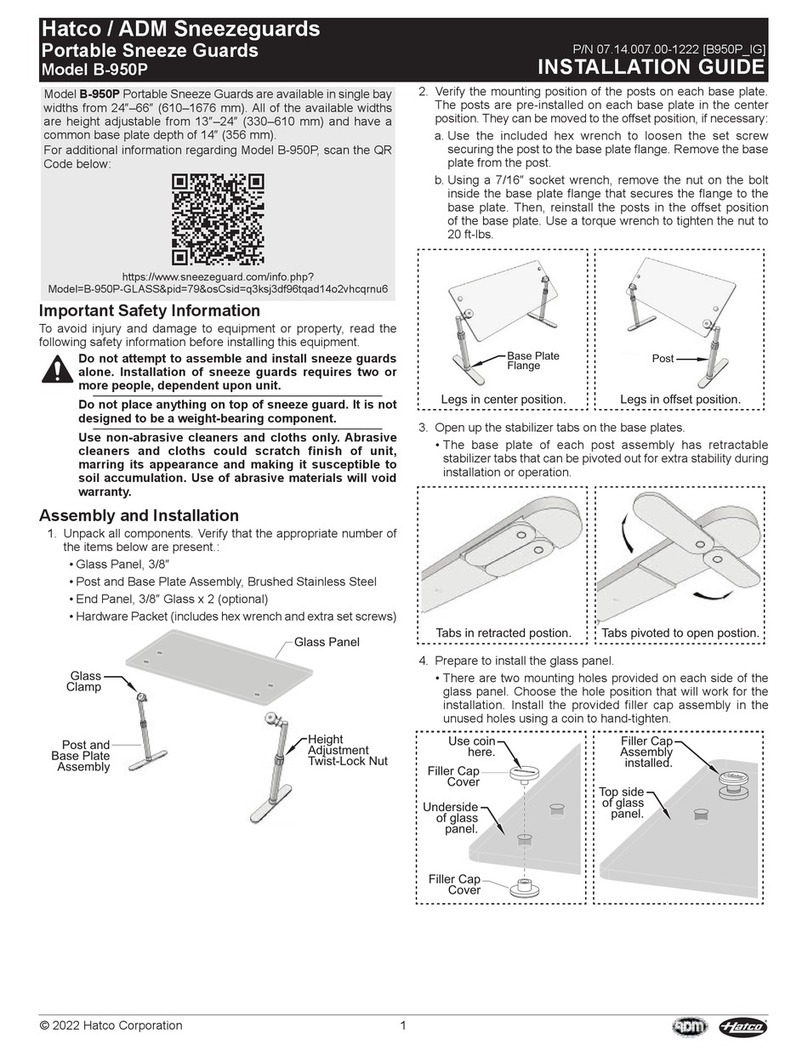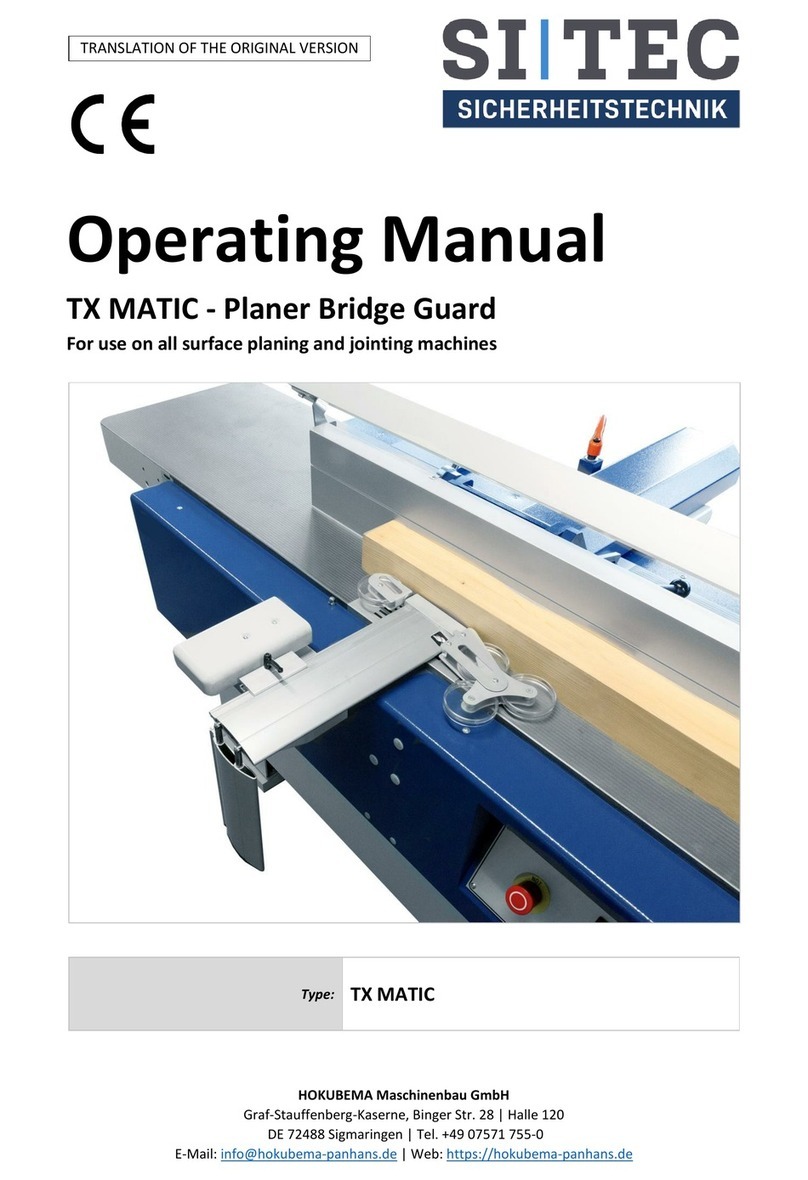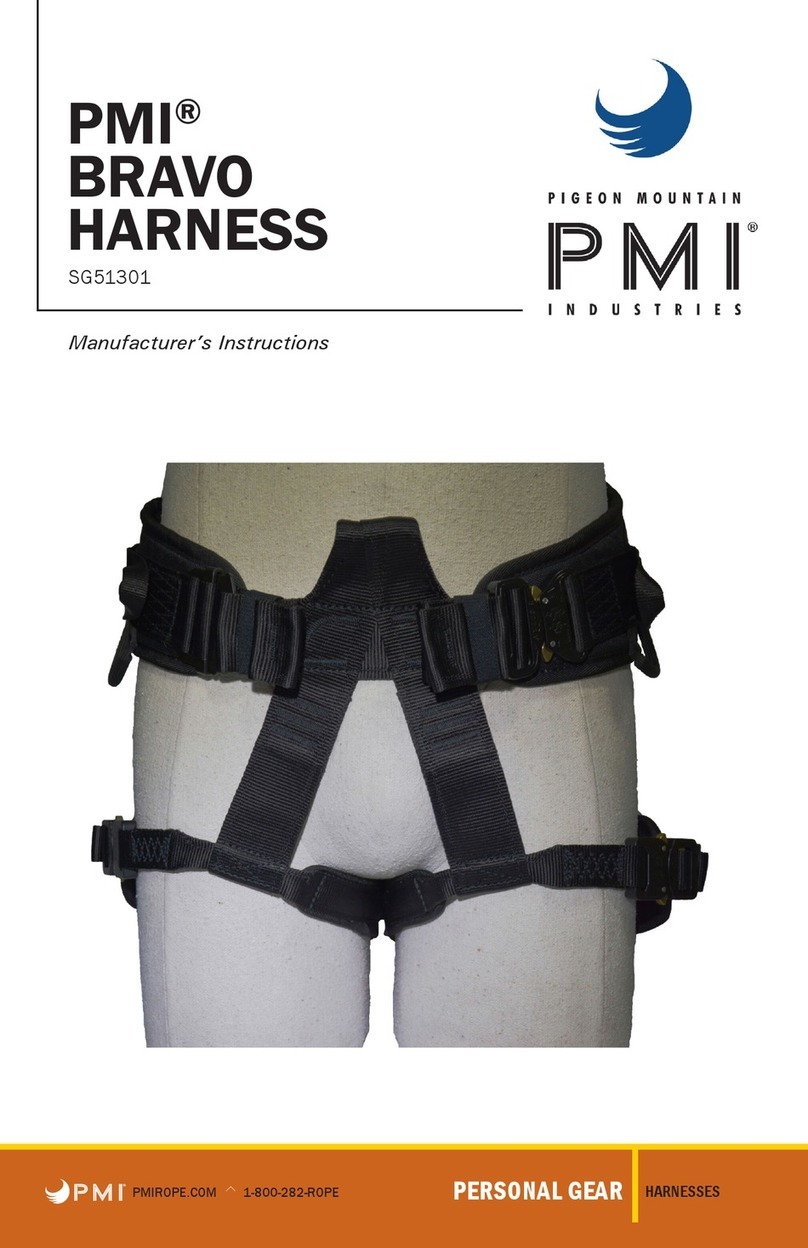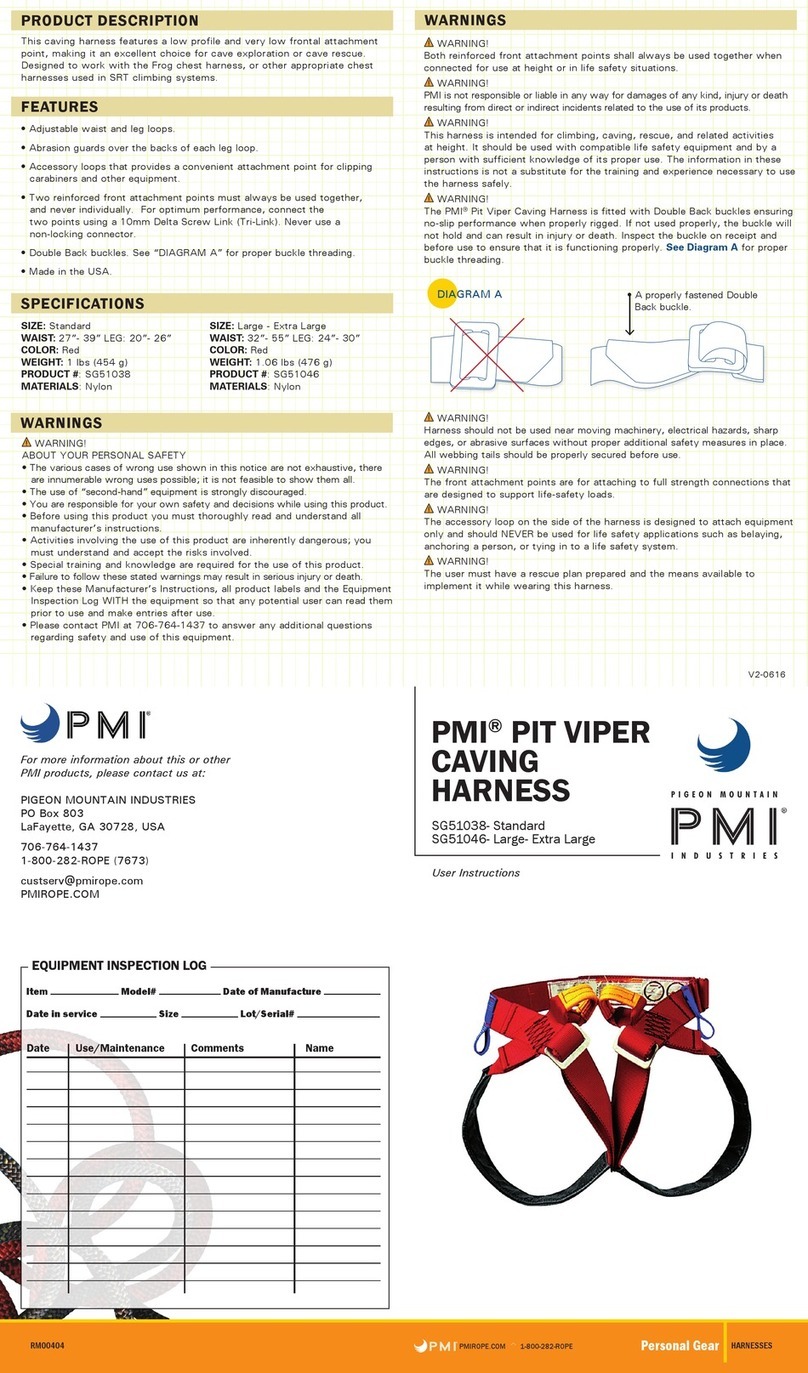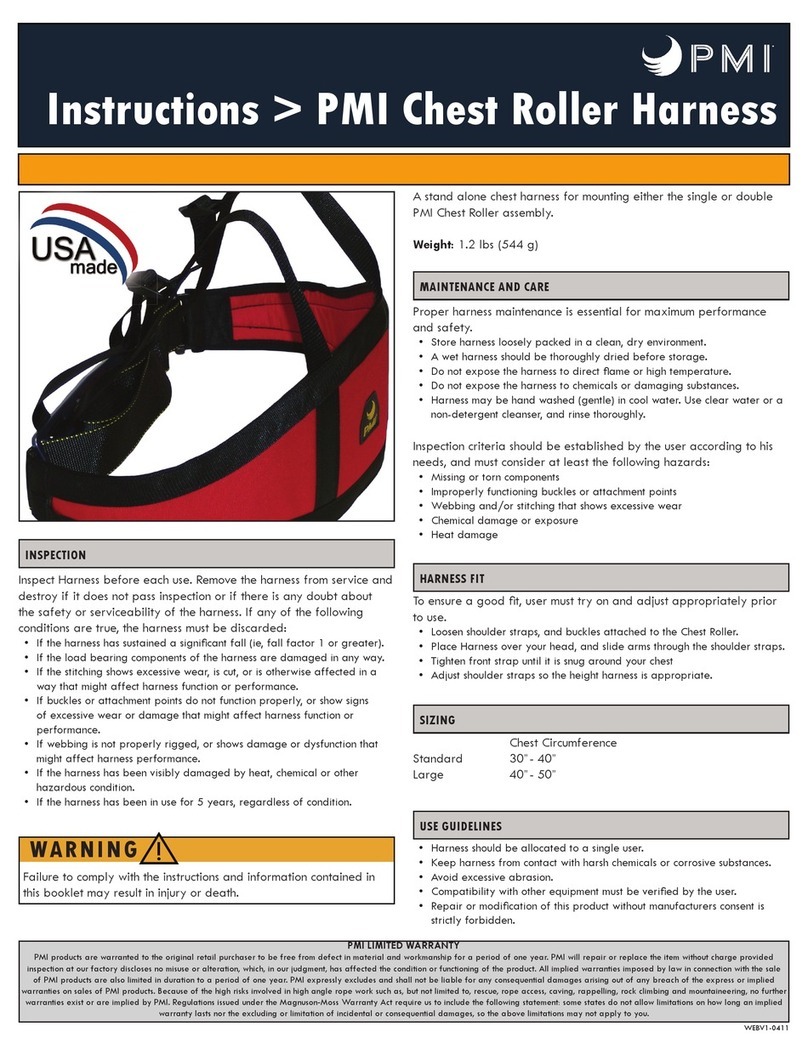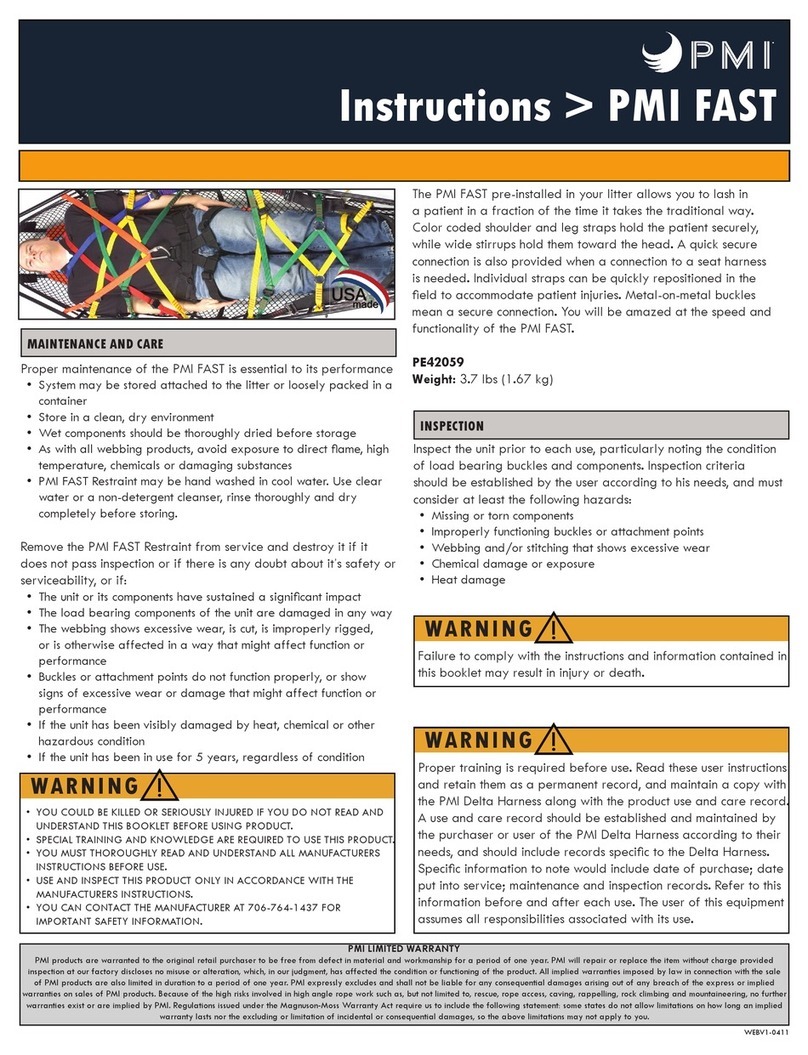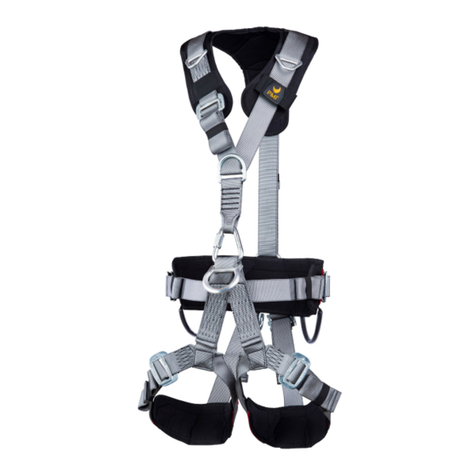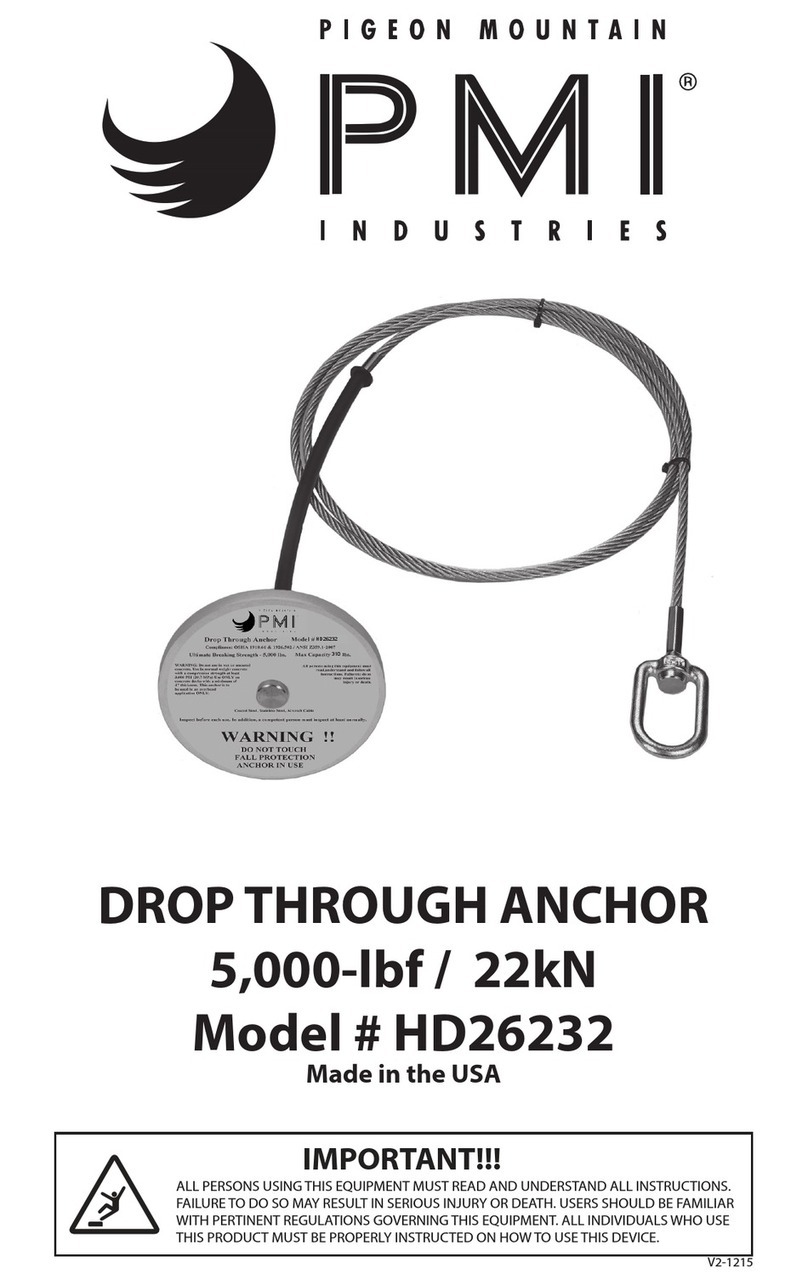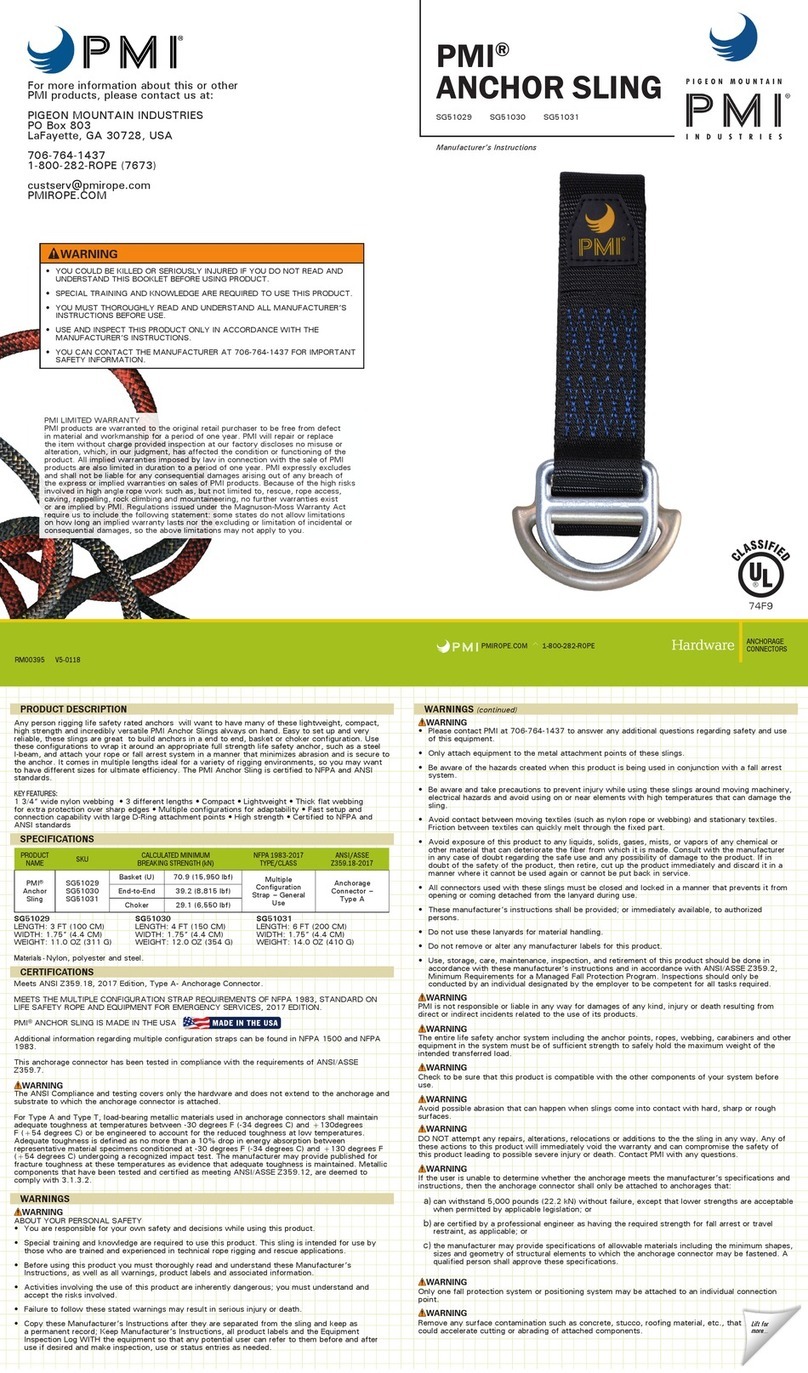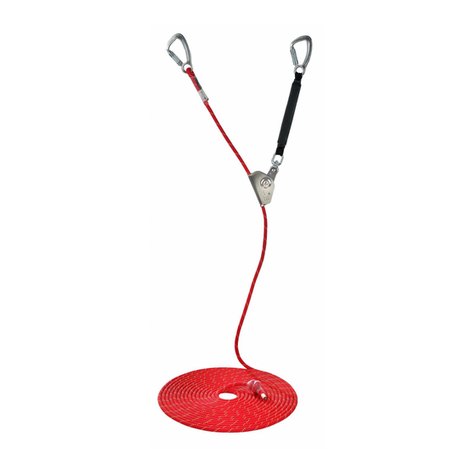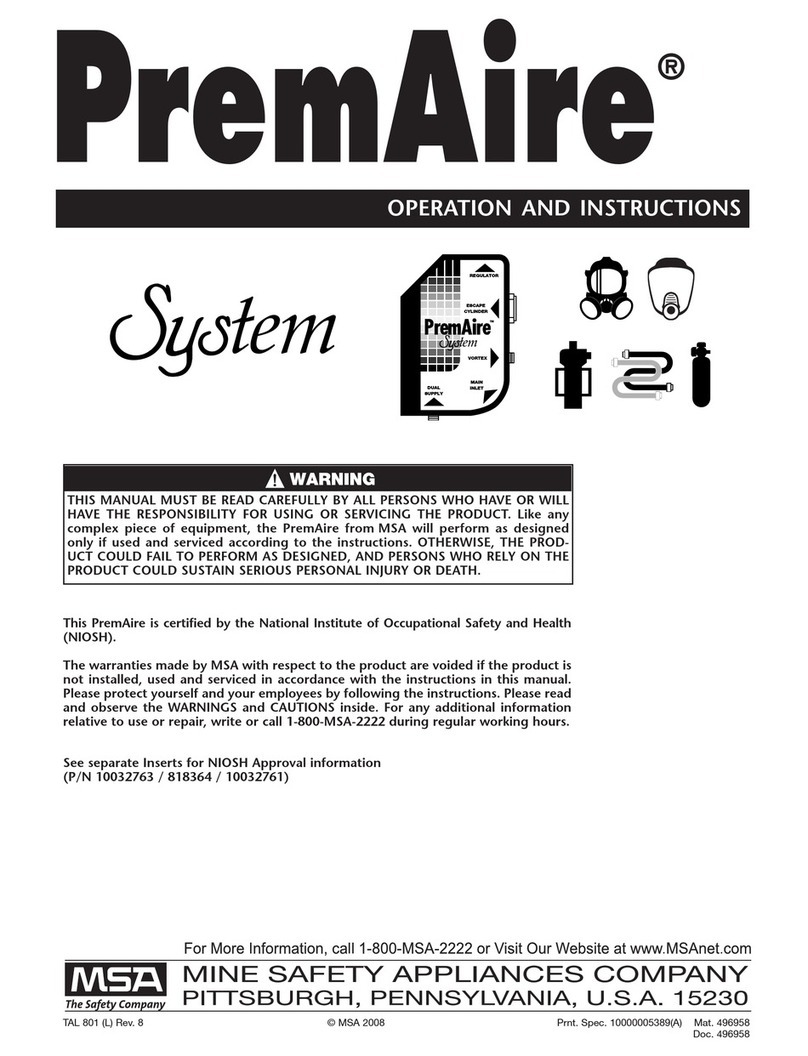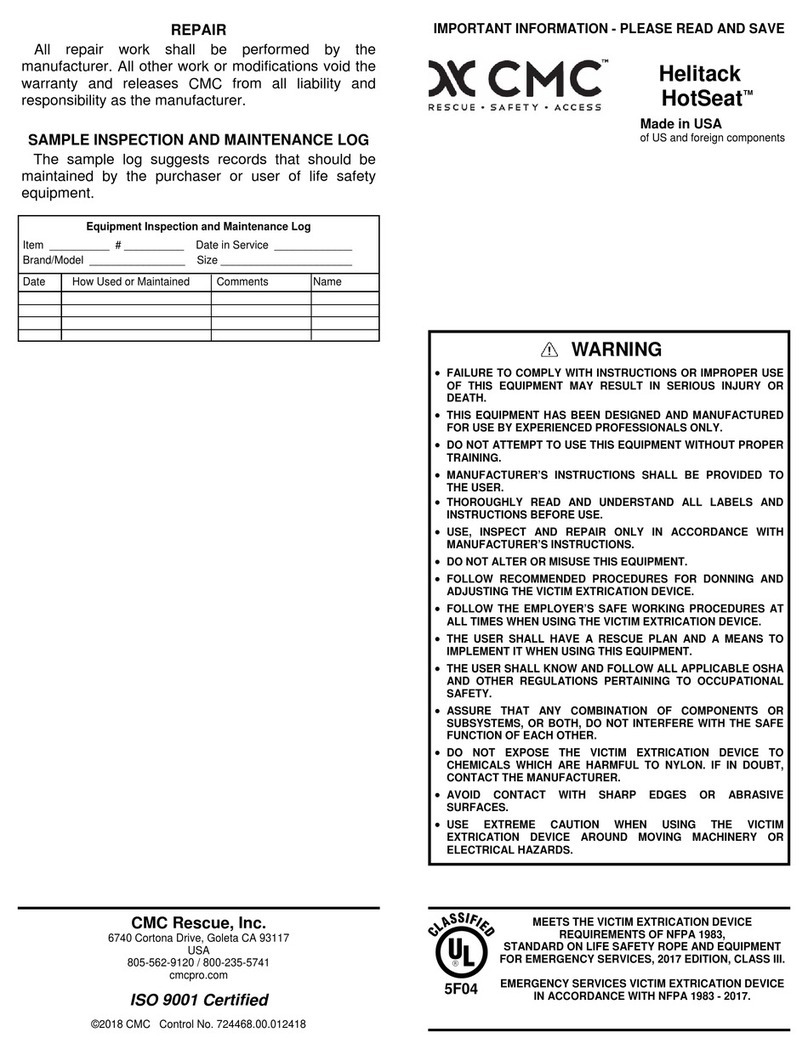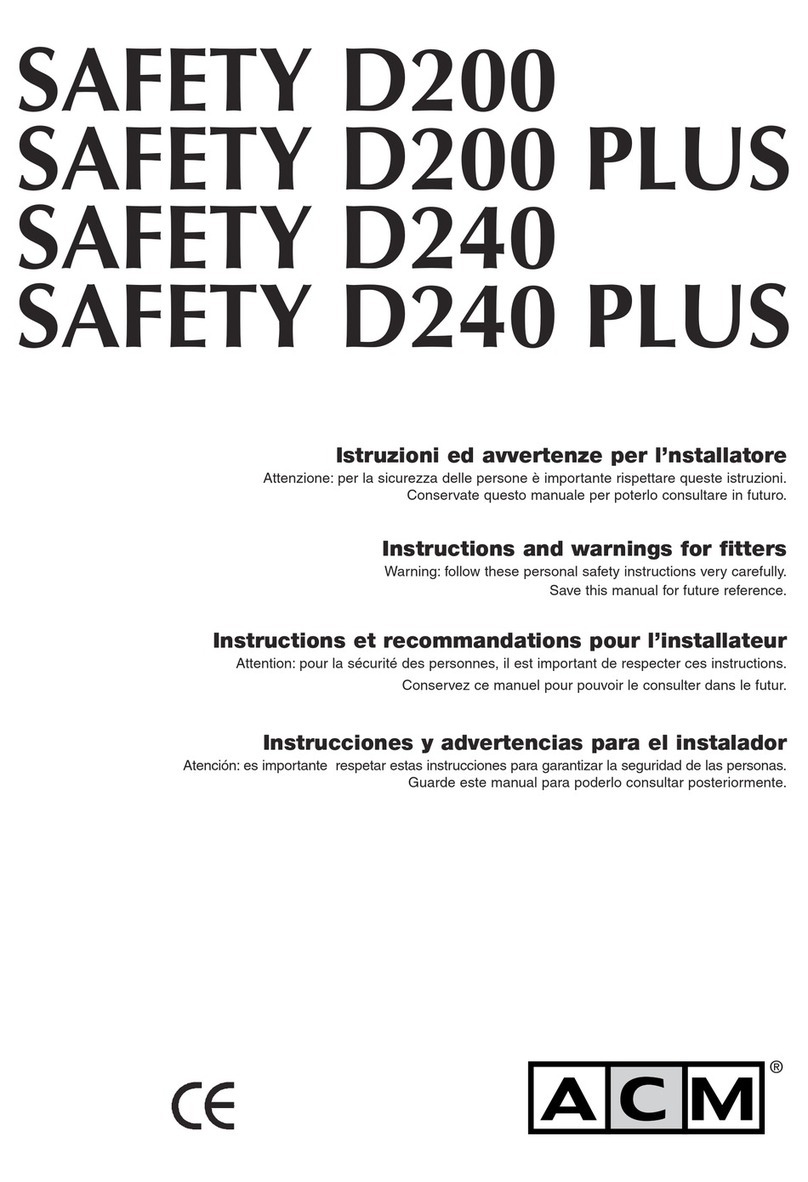
ESPAÑOL CONTINUÓ
DESCARTE DE INMEDIATO cualquier cuerda que tenga más de 10
años sin importar su historial ni su uso.
DESCARTE DE INMEDIATO cualquier cuerda cuyo historial y uso
anterior sean inciertos.
CORTE LA CUERDA DESCARTADA en pedazos pequeños, los cuales no
fomentará su uso en el futuro, o deshágase de ella por completo. Una
cuerda descartada no se debería almacenar, mantener o conservar de
tal forma que se pueda usar por error como una cuerda de seguridad
humana. En algunos casos, cuando sólo un punto o un área pequeña
de cuerda ha sufrido daños y el resto de la cuerda todavía está en
buen estado, el usuario puede escoger cortar esa sección de la cuerda
y continuar utilizando la(s) cuerda(s) más corta(s) para aplicaciones
de seguridad humana. Esta es una decisión que depende del juicio del
usuario y la misma se deja a su discreción.
PROCEDIMIENTOS DE INSPECCIÓN PARA LAS CUERDAS PMI
ANTES DE COMENZAR: Se debe inspeccionar todas las cuerdas
para ver si hay señales de desgaste y daño antes de cada uso. Si
no se ha inspeccionado, NO LA USE. Siempre inspeccione toda la
cuerda, aun cuando no vaya a usar toda. Tenga en mente que es
difícil inspeccionar una cuerda mojada. Es mejor secarla antes de
inspeccionarla. Permita que una persona inspeccione por completo
una cuerda. Si comienza a dividir este trabajo entre varias personas,
puede que pasen por alto algo importante.
CÓMO INSPECCIONAR SU CUERDA
1. Revísela... ¡Toda! Comience con un extremo y revise con la vista
cada centímetro de la cuerda. Esté pendiente de señales que
puedan indicar un posible daño, tal como la decoloración, los olores
químicos, la abrasión, los cortes o rasguños en la cubierta exterior
y las diferencias visibles en el diámetro de la cuerda en un área en
comparación con el resto de la cuerda.
2. Enrolle la cuerda en círculos pequeños y ¡mírela! Enrolle la cuerda
alrededor de la mano para formar círculos pequeños en distintos
puntos escogidos al azar a lo largo de la cuerda. Mire estos círculos
pequeños según los hace, la consistencia de los mismos debe ser
uniforme por toda la cuerda. Si no es así, puede que haya un
problema con el centro de su cuerda.
CÓMO INSPECCIONAR SU CUERDA
3. ¡Sienta la cuerda! Mientras revisa cada centímetro de la cuerda con
la vista, pase la cuerda por las manos, sin guantes, y trate de sentir los
cambios que puedan signicar daños al centro. Estos cambios pueden
incluir cualquier inconsistencia en el diámetro de la cuerda, puntos
suaves o blandos, o áreas extremadamente duras.
4. ¡Anótelo todo! Anote los resultados de su inspección en la bitácora
de cuerda que se incluye con su cuerda. Asegúrese de incluir cualquier
cosa que haya encontrado durante su inspección que pueda ser
o convertirse en un problema y documente información adicional
importante relacionada con la cuerda, tal como situaciones de carga
aplicada excesiva o descontroladamente, cuerdas que tienen más de
10 años, contacto con sustancias químicas nocivas e historial de uso.
Anote en la Bitácora de Cuerda cada vez que algo le ocurra a la
cuerda, incluido cada vez que la use, la inspeccione, la limpie, la seque
o cualquier problema.
¡Si tiene duda, A LA BASURA! Si no está seguro de la integridad
de una cuerda....¡NO LA USE! Consulte con el fabricante si necesita
ayuda.
PROCEDIMIENTOS DE LIMPIEZA PARA LA CUERDA
Lávela – Usted puede lavar las cuerdas sucias a mano o en una
lavadora comercial de carga frontal. Utilice agua fría a tibia con
un jabón suave. Los jabones sin detergentes son los mejores, pero un
detergente suave es aceptable si se usa en pequeñas cantidades.
En todo caso, el jabón que se utilice no debe contener agentes
blanqueadores. Evite usar lavadoras de carga superior y con
agitadores porque enredan severamente la cuerda y hasta pueden
causar daño debido a la fricción producida por el roce de la cuerda
sintética contra el agitador sintético.
Desinféctela – Sólo se necesita desinfectar la cuerda si se sospecha
que ha tenido contacto con patógenos transmitidos por la sangre.
Para desinfectar la cuerda de estos patógenos PMI recomienda
seguir la norma de la NFPA para la limpieza del equipo de rescate
de los patógenos transmitidos por la sangre. Prepare una solución
de 60 ml de blanqueador común por cada 4 litros de agua o una
taza por galón. Remoje la cuerda por 10 minutos en esta solución,
entonces enjuáguela completamente o lávela según se ha mencionado
anteriormente. El ciclo de enjuague es crítico para prevenir cualquier
daño a la cuerda por el blanqueador. Deje que la cuerda se seque en
un ambiente fresco, seco y bien ventilado.
Lubríquela – Las cuerdas pueden resecarse y perder exibilidad a
causa del lavado. Usted puede prevenir esto al añadir de vez en
cuando un poco de suavizante (apróximadamente una taza) al ciclo
de enjuague del lavado de la cuerda. No use más de esta cantidad o
puede causarle daño a la cuerda.
Séquela – Seque su cuerda en un lugar limpio, seco y protegido de la
luz directa del sol. Evite 1) usar las secadoras comerciales, 2) poner
las cuerdas mojadas en una supercie de cemento y 3) exponer las
cuerdas a emisiones de escape. Para los mejores resultados, la cuerda
debe colocarse en un rollo suelto o enrollarse alrededor de dos
objetos en un ambiente de poca humedad.
Anótelo – Recuerde documentar la limpieza en la bitácora de cuerda.
Manténgala limpia – Después de reempacar su cuerda, guárdela en
un lugar limpio, oscuro y seco, lejos de la exposición a ácidos u otras
sustancias químicas nocivas, gases tóxicos u otro maltrato.
TIPOS DE CUERDA
A las cuerdas se les asignan designaciones de tipo en las diversas
normas con las cuales cumplen.
CI 1801 CLASIFICA LA CUERDA DE LA SIGUIENTE MANERA:
POCA ELASTICIDAD – Cuerdas con una elongación de 6-10% cuando
la resistencia mínima de ruptura es de 10%.
ESTÁTICA – Cuerdas con una elongación de menos de 6% cuando la
resistencia mínima de ruptura es de 10%.
NFPA 1983 CLASIFICA LA CUERDA DE LA SIGUIENTE MANERA:
ESCAPE – Cuerda de escape personal de emergencia con n único y
un solo uso.
USO LIVIANO – Diseñada para cargas livianas (300 libras) o escape.
USO GENERAL – Designada para cargas generales (600 libras),
cargas ligeras (300 libras) o escape.
EN 1891 CLASIFICA LA CUERDA DE LA SIGUIENTE MANERA:
Cuerdas Tipo A – son cuerdas kernmantle de poca elasticidad
diseñadas para uso general por personas que realizan trabajos
verticales en cuerda, incluso todo tipo de colocación en posición de
seguridad y restricción, para rescates y espeleología.
Cuerdas Tipo B – son cuerdas kernmantle de poca elasticidad de
menor rendimiento que las cuerdas Tipo A y que requieren más
cuidado al usarlas.
Cuerdas no especicadas como Tipo A ni Tipo B incluyen cuerdas
